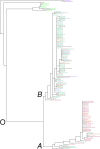Nucleotide variation and balancing selection at the Ckma gene in Atlantic cod: analysis with multiple merger coalescent models
- PMID: 25755922
- PMCID: PMC4349156
- DOI: 10.7717/peerj.786
Nucleotide variation and balancing selection at the Ckma gene in Atlantic cod: analysis with multiple merger coalescent models
Abstract
High-fecundity organisms, such as Atlantic cod, can withstand substantial natural selection and the entailing genetic load of replacing alleles at a number of loci due to their excess reproductive capacity. High-fecundity organisms may reproduce by sweepstakes leading to highly skewed heavy-tailed offspring distribution. Under such reproduction the Kingman coalescent of binary mergers breaks down and models of multiple merger coalescent are more appropriate. Here we study nucleotide variation at the Ckma (Creatine Kinase Muscle type A) gene in Atlantic cod. The gene shows extreme differentiation between the North (Canada, Greenland, Iceland, Norway, Barents Sea) and the South (Faroe Islands, North-, Baltic-, Celtic-, and Irish Seas) with FST > 0.8 between regions whereas neutral loci show no differentiation. This is evidence of natural selection. The protein sequence is conserved by purifying selection whereas silent and non-coding sites show extreme differentiation. The unfolded site-frequency spectrum has three modes, a mode at singleton sites and two high frequency modes at opposite frequencies representing divergent branches of the gene genealogy that is evidence for balancing selection. Analysis with multiple-merger coalescent models can account for the high frequency of singleton sites and indicate reproductive sweepstakes. Coalescent time scales vary with population size and with the inverse of variance in offspring number. Parameter estimates using multiple-merger coalescent models show that times scales are faster than under the Kingman coalescent.
Keywords: Atlantic cod; Balancing selection; Ckma; Multiple-merger coalescent; Time scales.
Conflict of interest statement
The authors declare there are no competing interests.
Figures



References
LinkOut - more resources
Full Text Sources
Other Literature Sources
Miscellaneous

